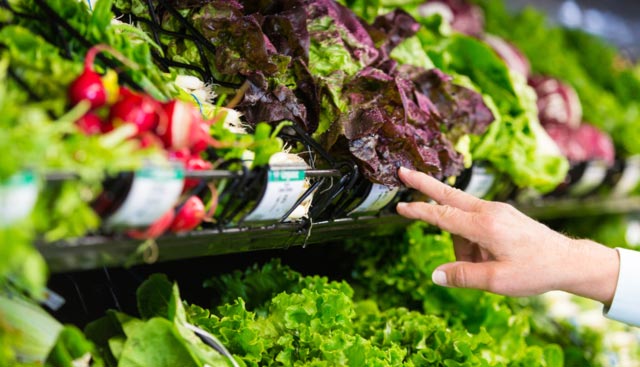
Top 10 Rock Star Vegetables
Going green: Are all leafy green vegetables created equal?
Dark green leafy vegetables come from a range of sources– from low growing shrubs, plants as well as tops of root vegetables like beets, carrots and radishes. They are versatile, have unique flavors, taste and textures, making them easy to incorporate at each meal to maximize their abundant nutritional benefits.
What are the top 10 “rock star” leafy green vegetables?
- Watercress
- Bok choy (Chinese cabbage)
- Chard
- Beet greens
- Spinach
- Chicory
- Romaine lettuce
- Collard greens
- Mustard greens
- Kale
How about iceberg lettuce?
Not all leafy greens are created equal. Among all green leafy vegetables, iceberg lettuce-which is probably the most widely used salad greens – contains the least amount of all the nutrients - practically only trace amounts, when compared to the other leafy green vegetables. The lighter the green, the lower the content of valuable nutrients.
What is the role of leafy green vegetables in health and disease prevention?
Dark green leafy vegetables are a rich source of nutrients, critical for optimum health and disease prevention. More specifically, dark green leafy vegetables are rich in the vitamin B - folate (derived from the word “foliage”), fiber, several vitamins and minerals and phytochemicals – carotenoids and flavanoids. Other major nutrients present in leafy green vegetables are vitamins A, C, E and K as well as minerals such as iron, magnesium, potassium and calcium. Dark green leafy vegetables are low in calories and carbohydrate and have a low glycemic index. They have no cholesterol or sodium content.
What is the role of dark green leafy vegetables in health and disease prevention, including cancer prevention?
Evolving research continues to show that these carotenoids and flavanoids present in these greens modulate several hallmarks of cancer, playing a critical role in protecting cells and blocking the early stages of cancer.
These dark greens contain a significant amount of folate, a B vitamin that promotes heart health; helps prevent certain birth defects and cancers. Folate is also necessary for DNA duplication and repair that is critical for protection against the development of several cancers.
Several large studies have shown that high intakes of folate may lower the risk of colon polyps and colon cancer risk, compared to low intakes of this vitamin. Other research suggests that diets low in folate may increase the risk of cancers of the breast, cervix and lung.
Other than cancer prevention, dark green leafy vegetables rich in folate have also been shown to reduce risk of heart disease and Type 2 diabetes.
Since these greens are low in calories and are rich in fiber, they should be a significant part of the meal to achieve and maintain a healthy body weight.
The fiber content of leafy green vegetables also alter the good bacteria in the digestive tract that can produce anti-inflammatory effects and allow for better absorption and utilization of carotenoids and flavanoids.
Does washing these leafy vegetables reduce the nutrient value?
As a rule, one must wash dark green leaves in cold water several times, prior to chopping and using in salads or cooking, even when these items are pre-washed. It does not wash away the nutrients. This is the safest way to consume fresh greens.
What are the best methods to cook leafy green vegetables?
The best way to enjoy the “rock stars” of leafy green vegetables is to simply consume them raw – in a salad, using them as wraps or by juicing them with fruits and other vegetables. Thicker, dark green leafy vegetables like kale, chard and even spinach are best when braised, sautéed, roasted or in soup.
A stir-fry of dark greens in extra virgin olive oil with chopped shallots, garlic, salt and pepper makes a hearty side. Using leftover stir fried greens in omelets, adds greens to breakfast!
Cooking concentrates the vitamins and minerals and can remove some of the bitter taste in dark green leafy vegetables. However, water-soluble vitamins such as vitamins C will be lost if you are chopping them to a very small size, overcooking and throwing off the water.
Leafy green salads colored with red, yellow and purple tomatoes, garnished with sprinkles of feta and pine nuts and a dash of balsamic and olive oil are interesting.
Similarly combining lean meats like chicken or fish, garnished with carrots and cucumber in a wrap of dark green leaves make excellent summer lunches.
Thicker green leaves like chard and kale make hearty soups when combined with chicken and beans.
Greens from beets, carrots and radishes are rich in fiber and nutrients. These leaves make great smoothies when combined with other vegetables, fruits and almond or cashew milk.
How long can you store them in your refrigerator?
Fresh leafy greens can be stored in crisper section of the refrigerator for three to five days. Thicker greens can be blanched and stored in the refrigerator or freezer for two to three weeks in sealed bags.
How much of dark green leafy vegetables should one eat in a day?
If the goal is to consume 10 vegetables and fruits a day, dark green vegetables should comprise 30-40 percent of this number.
One cup of dark green leaves constitute one vegetable. That is easy!
What are the leafy green vegetables currently being used or tested for cancer prevention?
Indole-3-carbinol, isothiocyanates as well as sulforaphanes extracted from crucifeous vegetables including cabbage, Brussels sprouts and broccoli is being examined for prevention of bladder, prostate, melanoma, head and neck and lung cancers.
